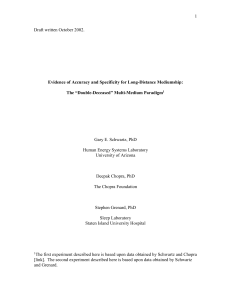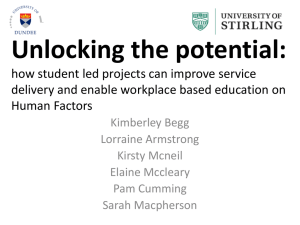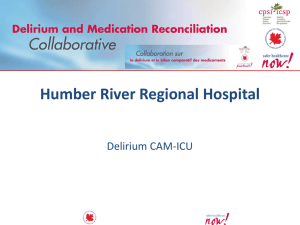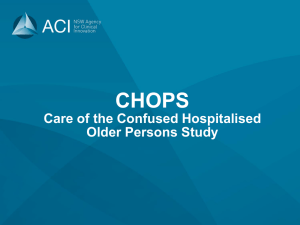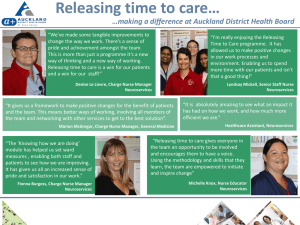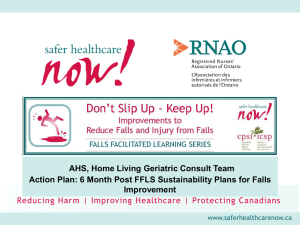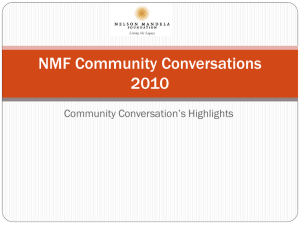All About Safety Sitters
advertisement
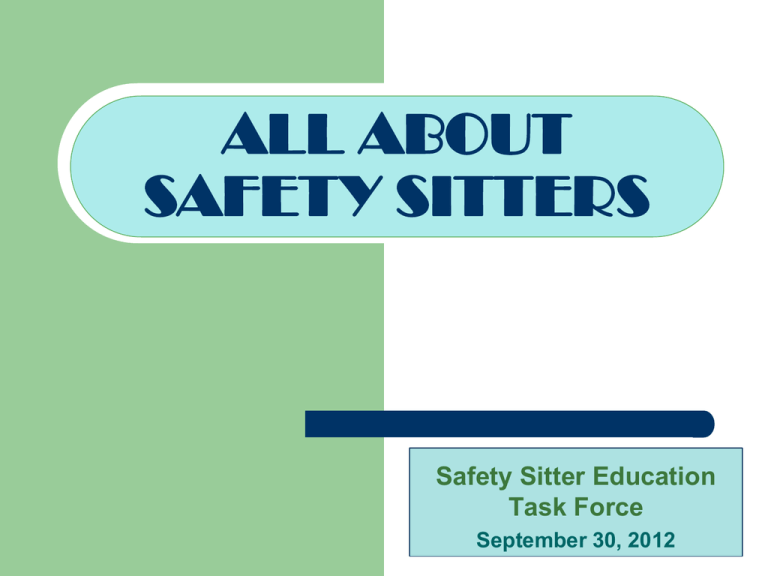
ALL ABOUT SAFETY SITTERS Safety Sitter Education Task Force September 30, 2012 Objectives The learner will be able to… 1. Identify what actions should be taken prior to requesting a safety sitter 2. State how to request a safety sitter 3. Familiarize and utilize strategies to keep patient safe Safety Sitters Definition: A safety sitter is an individual trained to observe and sit with a patient to keep them safe A safety sitter may be an Observation Assistant (OA) or a Patient Care Technician (PCT). PCT safety sitters should perform functions of a PCT for the patient they are sitting for For the purposes of this training, we are not referring to sitters used for : – suicide precautions or – behavioral restraints in the inpatient setting Purpose of Safety Sitter Education To provide strategies in addressing the increasing need of safety sitters To inform staff of available resources in addressing the safety needs of patients To efficiently use our sitter resources Safety Sitter Algorithm A Safety Sitter Algorithm has been created as a reference to guide staff in identifying patients needing safety sitters The algorithm, policy and resources are available on the intranet site under: Contents Safety Sitter The following slides will highlight key points in the algorithm Safety Sitter Algorithm The initial steps in using the algorithm involve determining patient’s behavior. The nurse will: ~ Assess the patient and attempt to identify the cause of the behavior ~ Address the cause with an appropriate intervention ~ Notify the Administrative Supervisor if suggested strategies are ineffective Safety Sitter Algorithm Addressing Patient Condition There IS an improvement in patient’s behavior This is NO improvement in patient’s behavior – – Collaborate with the doctor and charge nurse This may involve additional diagnostic testing, a MET or even a transfer to a more appropriate unit – – – – Initiate appropriate strategies to keep patient safe Use your resources Consult with families to see if they can be of assistance Offer private sitters if needed Strategies to Keep Patient Safe Rounding Music Therapy Delirium Protocol Animal Assisted Therapy Fall Prevention Protocol Sleep Enhancement Pain Management Protocol Consult with Geriatric APN Patient Activity Progression Protocol Consult with Mental Health Staff Bladder Scan Protocol Ask Family to stay Use of Activity/Book Carts Offer use of Agency sitters Use of Thermo-flect Blanket Use Unit Resources Use of Delirium Protocol The Delirium Protocol is an excellent resource to assess patients who may be developing delirium. It should be used for: – – – Assessing patients at risk for development of delirium Identifying possible precipitating factors for development of delirium and possible nursing actions Identifying appropriate interventions for prevention/treatment of delirium Comfort and Spirituality Meals and hydration Mobility Communication and orientation Relaxation and Sleep Medication Management Highlights of Delirium Protocol Encourage family participation Offer religious objects and reading materials Prevent or treat constipation and/or urinary retention Offer toileting every 2-3 hours Provide companion and assist with feeding and meals Use relaxation activities- activity cart, breathing techniques, music, hand massage, Sleep promotion, non-medication alternativesmusic Orient to the environment- use reminiscence, life review & conversation. Review “Who Am I” Use of stuff animals for the elderly Early mobilization and regular exercise as medically allowed Pain assessment Range of motion exercises 3 times daily for bedrest patients Allow patient participation Ensure hearing aides and glasses are used and in working order. Offer hearing enhancer or magnifiers. Consult with physician about appropriate medication management Consult with pharmacy regarding medication interaction Consult with Geriatric APN – Julia Knight Highlights of Protocols Rounding & Pain Management Culture of caring - 4 Ps Pain- Assess pain and medicate PRN Potty- Offer toileting Position patient every 2 hours Presence Fall Prevention Assess patient risk Identify patient at risk Use of yellow socks Call light accessible Bed alarm as necessary Highlights of Protocols CIWA/DT CIWA/ DT Patients Patients Purpose: provide direction and medication management of patient in DTs Highlights ~Medicate every 2 hours ~Follow CIWA protocol Animal Assisted Therapy Purpose: provide companionship and diversion for patients Highlights ~ call x. to request for AAT visit ~Follow AAT guideline on what is appropriate ~ no visit with isolation patients Highlights of Protocols Sleep Enhancement Protocols Purpose: assist patients in promoting relaxation conducive to sleep Highlights ~ Use of music ~ Promote a quiet atmosphere ~ Medication, if appropriate ~ Bath/Backrub at night ~ Warm milk Patient Activity Progression Protocols Purpose: Increase activity to avoid boredom and relieve restlessness Highlights ~ ambulate when appropriate, if restless ~ restless in bed- get patient up to a chair Highlights of Resources Use of Care /Book Carts Purpose: Provide diversion activities to occupy patients time Locations- Each unit has one. refer to each unit for location Use of Thermo-flect Blanket Purpose:Provide warmth and comfort Follow thermoflect policy Role of Families Families are an untapped resource Families can be brought in to assist in keeping their loved one safe – – Families are familiar with patient routines at home and may know strategies to keep patient calm and safe Familiar voice or face can be calming to patients Families can hire outside assistance and use an Agency Sitter (List on the intranet) Unit Resources Unit Charge Nurse Unit Manager Unit CNS/Clinical Educator Unit GRN (Geriatric Resource Nurse or Gero Certified RNs) Geriatric APN (Julia Knight x. ) Consult with Pharmacy (x. ) Consult with Mental Health (x. ) NICHE Module Safety Sitter Intranet Site (Intranet->Content-> Safety Sitter education) Administrative Supervisors (x7933) Safety Sitter Education Task Force Members Role of Administrative Supervisor When the Administrative Supervisor (AS) is called, they will consistently ask: – – – – Patient behavior Intervention Attempted Family available How will you keep patient safe if sitter is not available The AS can help determine if an NCH sitter is available Safety Sitter IS Available If a sitter is provided, the unit will have give sitter report: – – – – Nurse must give sitter handoff sheet to sitter and give report to sitter on details outlined on the sitter handoff sheet Identify PCT resource for sitter for sitter breaks and other issues Provide extension number for charge nurse and patient’s nurse to sitter Round on patient every hour Sitter usage needs to be reassessed every 2 hours Notify supervisor of changes in sitter need Safety Sitter IS NOT Available If a sitter is not available, the unit will be asked to: – – – – – Ask family to stay with patient Assign own unit PCT or rotate watching patient. Consider strategies & diversion activities Consider Bed alarm, mitts and other device Consider use of restraints as last alternative Scripting Guide for Staff Conclusion There are many ways to keep our patients safe and NCH has developed a comprehensive list of resources to be used by bedside clinicians. It is key for staff to be familiar and understand the strategies and resources available for the complexities of keeping patients safe Working together can make a difference QUESTIONS Contact your leadership or Safety Sitter Education Task Force Claudette Johnson Mary Webb Lori Balek Shime Herrera Zita Nadal Denise Krantz Thank you for your commitment to improve patient care by effectively utilizing staff, maximizing use of our resource and more importantly, keeping our patients safe. 10.21.12

